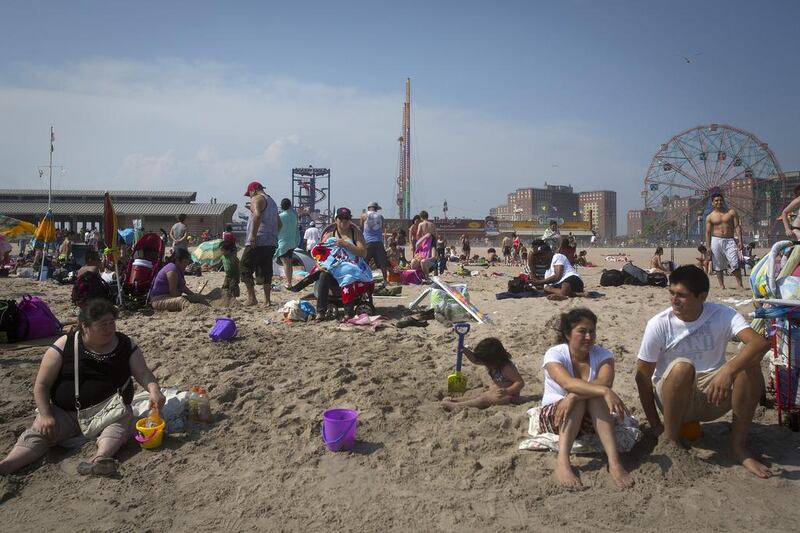When it comes to thinking about cities, the view from his temporary home at New York University Abu Dhabi provides Suketu Mehta with all the material he needs.
“When I look at a place like this, I wonder what genius of an urban planner thought that it would be a great idea to make a city without sidewalks and decided that the automobile would have primacy over the pedestrian?” the writer wonders, looking across Saadiyat Island’s twisting motorways and flyovers towards the hotels that line its distant coastline.
“I’d love to be able to walk to the beach but I can’t really go for a walk outside this apartment. And, as you can see, I’m literally at the end of my road,” he says, pointing to a patch of waste ground beneath his window where six lanes of motorway simply disappear into the sand.
More than his role as an associate professor of journalism at New York University, his alma mater, it’s Mehta’s thinking and writing about urbanism that have brought him to NYUAD.
Since January, the award-winning author of Maximum City: Bombay Lost and Found has been teaching a course at the university that not only involves looking at fiction, film, non-fiction and poetry, but also includes field trips to places such as Dubai's Hor Al Anz, a neighbourhood that he considers to be one of the UAE's more inspiring destinations.
“It’s the Jackson Heights or the Southall of Dubai. We hung out, we walked the streets, had a biryani and I really felt at home,” Mehta enthuses.
“The more time I spend here the more I realise how little I know and how wrong the rest of the world is about this place,” he says. “It’s much more complex.”
It is difficult to consider a contemporary writer who is more committed to cities and city life than Mehta.
Born in Kolkata in 1963, he spent his early years in Mumbai before his family moved to Jackson Heights, a multicultural neighbourhood in Queens, New York, in 1977 and it was 21 years before he returned to the city he still refers to as Bombay.
After years spent working as a journalist and editor for business-to-business computing titles, Mehta returned to India with a determination to write and a seductively simple question: Can you ever go home again?
“I thought I would go to Bombay for a year to write a quick and dirty book about a quick and dirty city,” Mehta told the writer William Dalrymple in a panel discussion at last year’s Zee Jaipur Literary Festival in Boulder, Colorado.
Fortunately, as it turns out, the budding writer was mistaken. Mehta spent two and a half years immersed in the company of gangsters and hitmen, Bollywood moguls and call girls, police chiefs, religious rioters, actors and politicians.
“In Bombay I met people who lived closer to their seductive extremities than anyone I had ever known. Shouted lives,” Mehta writes in the book that resulted from his unexpected sojourn.
“These are not normal people. They live out the fantasies of normal people. And the kind of work they do affects all other spheres of their lives ... in this sense they have become artists.”
Published as his first book in 2004, Maximum City earned Mehta a place on the finalist's list for the Pulitzer Prize in 2005 and catapulted him, then 41, to the forefront of world literature.
Before long, Maximum City came to be considered not just as a great book about a great Indian city, Mumbai's answer to Ahmed Ali's Twilight in Delhi or Geoffrey Moorhouse's Calcutta, but it also earned Mehta a place in the pantheon of literary urban investigators alongside Dickens and Orhan Pamuk, Joseph Mitchell and Jan Morris.
Since the publication of Maximum City, Mehta has spent a decade writing articles for publications such as The New Yorker, The Guardian, Time magazine, and Newsweek while working on a new translation of Mahatma Gandhi's autobiography and researching material for his next book, a study of the immigrant experience in New York tentatively titled City of the Second Chance.
At the same time, Mehta, whose accent still ties him to Mumbai and bears no trace of his many years in the United States, has been visiting cities as the only writer to participate in Urban Age, an itinerant city research programme established by Richard Sennett and Ricky Burdett at the London School of Economics.
"I've never taken a course in urbanism or architecture, but after Maximum City I was asked to be part of this travelling group of urbanists, planners, architects and mayors," he says.
“I started getting invited to their conferences in cities all around the world where there were all these debates taking place about the future of cities. I started wondering why they invited me, a complete amateur at all this, and I realised that it’s because the story of the city needs to be told.”
For Mehta, writing about cities and the deliberations of the people who have the power to shape their future is a civic duty and helps to ensure that, rather than talking about buildings, the debate around our urban future focuses on people instead.
“The jargon of urbanism has become like a Latin mass and this is where I think storytelling needs to re-enter the whole conversation,” he says. “There’s a role for journalists and writers to listen to the deliberations of the good and the great and to translate this into stories for the rest of us.
“If you’re a literary theorist or a philosopher you can write in obscure journals, but it will not have much effect on the rest of the public. But the dreams of urban planners can become our nightmares because we have to live with them.”
The outcome of all this travel, research and meetings with urbanism's great and good is a book-length essay, The Secret Life of Cities, that Mehta describes as an amuse-bouche for his forthcoming book about New York.
Focusing on migration, alienation and community in the world’s cities, the book, which is yet to be published in English, examines just what it is that makes great cities great, a quality, Mehta insists, that is quite different from the liveability indexes produced by organisations such as the Economist Intelligence Unit.
“The world’s most liveable cities always include places like Canberra and Munich, places made for expat bankers that completely bore the s*** out of me,” Mehta says.
“I think there needs to be another list of liveable cities that considers that metropolitan excitement, that sense of chaos and informality and a little bit of unpredictability, even a little frisson of danger. This is what makes for a great city.”
Rather than the sterile lakeside sidewalks of cities such as Geneva, the epitome of the kind of vibrant urban environment that Mehta favours is the Coney Island boardwalk and beach in New York, which serve as a metaphor for a workable urbanism that is open and realistic.
“A great city doesn’t have to include everyone. You could sit at Ruby’s Bar in Coney Island and watch the whole parade of humanity,” he says.
“Bangladeshis in their hijabs next to Russian girls in bikinis, and anarchists from the East Village in leather and Dominicans, and they all walk side by side before going off to their little knots on the beach.
“It’s not that they’re all happy and talking to each other. It’s not that you’ll get invited to every picnic on the beach, but somewhere on the beach there’s a picnic that you too can go to.”
The alternative view, as Mehta sees it, is a socialist notion of equality that he rejects as utopian and unrealistic, preferring instead to focus on openness, tolerance and dignity.
It is an approach that is heavily influenced by Mehta’s upbringing and from his teenage years when he grew up in a building in Jackson Heights in Queens, the easternmost and largest of New York’s five boroughs and a district that is statistically and linguistically the most diverse in the US.
In the building where the Mehta family lived, which was owned by a Turk and managed by a Greek, Indians lived alongside Pakistanis, and Jews lived next to Muslims.
“It’s not that we started loving each other. When we went inside we all said horrible racist things about somebody else. But there was a cessation of hostility and an understanding that we were all making a new future,” Mehta says.
When it comes to the UAE’s future, the real stories, he believes, lie not in the architectural visions that adorn the property developer’s hoardings he sees from his window, but in the backstreets of the neighbourhoods where the vast majority of Abu Dhabi’s population lives.
“This city is made up of layers, but the most visible layer – the one you see in advertisements and on airlines – is only the tip of it,” he says.
“There are all these other layers that are South Asian and Filipino and African and Egyptian, and the most interesting parts of the city are the interstitial spaces where these bubbles mix.
"There's a great Maximum Abu Dhabi or Maximum Dubai to be written," Mehta insists. "I'm certainly not the person to write it, but I think somewhere out there there is a young writer – they could be Emirati, they could be Pakistani or they could be English – who is collecting observations and stories and will write the great non-fiction book about this city, because it certainly demands it."
nleech@thenational.ae
Suketu Mehta will be reading from The Secret Life of Cities at New York University Abu Dhabi on Wednesday night at 6.30pm in room A3002.





